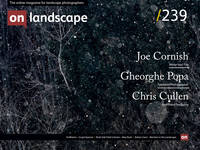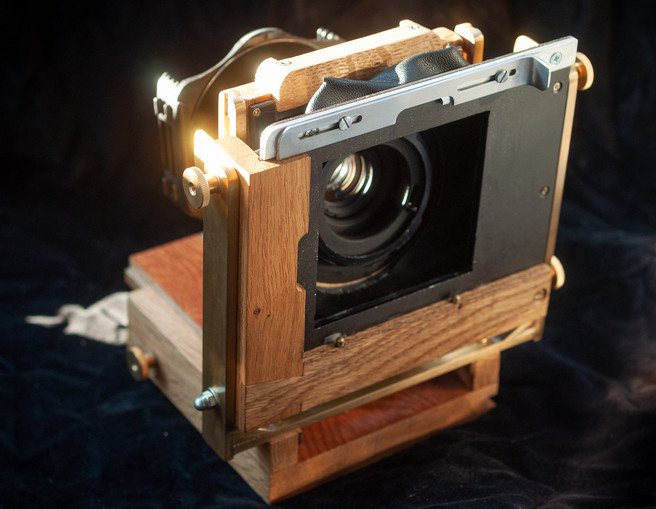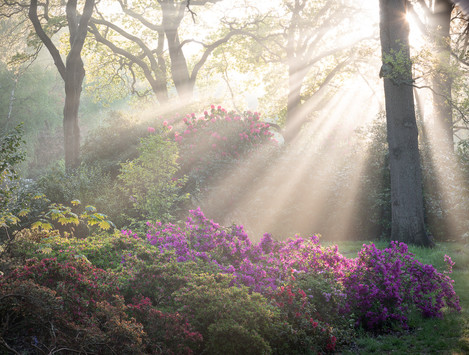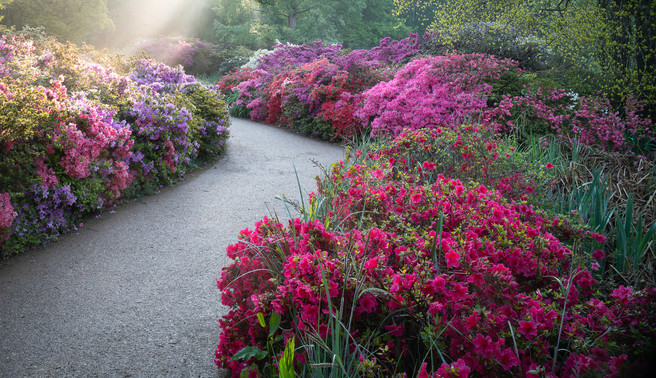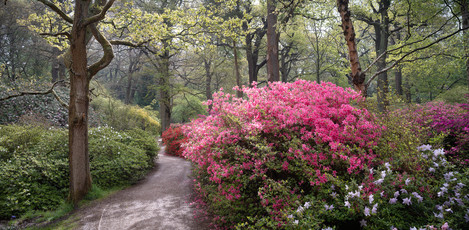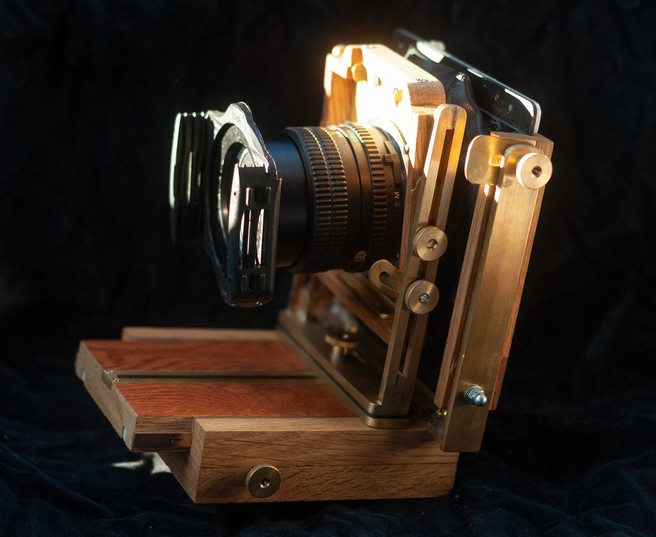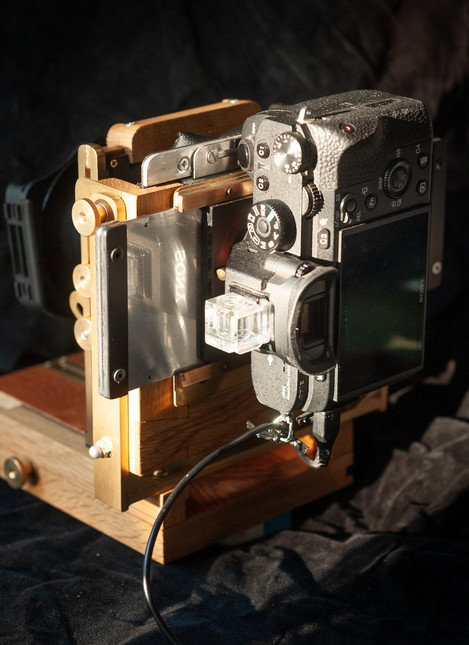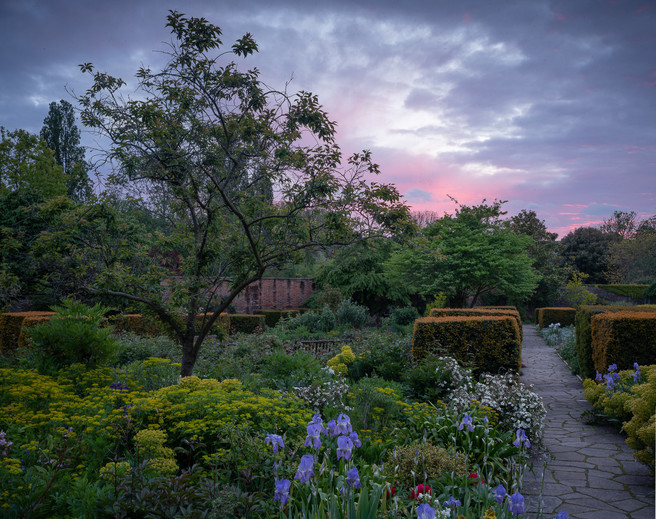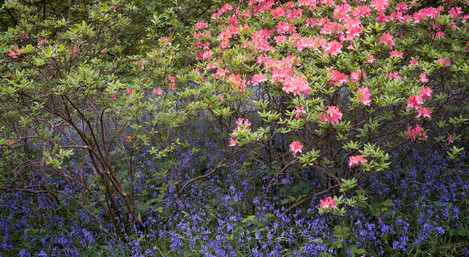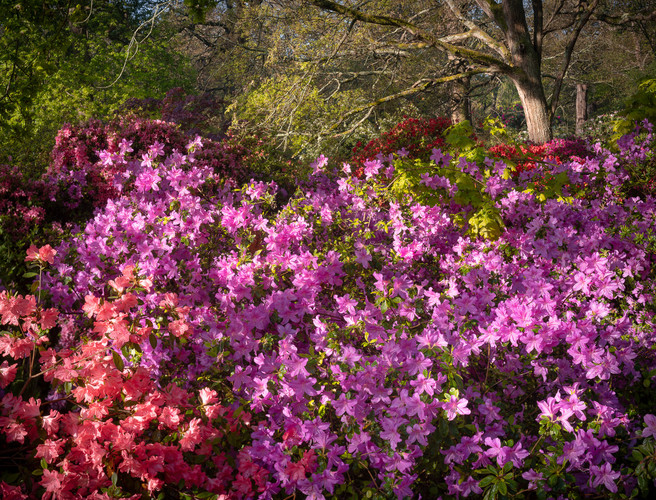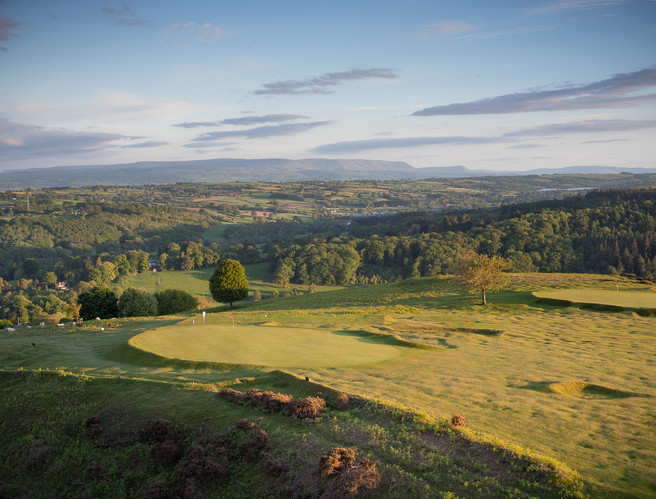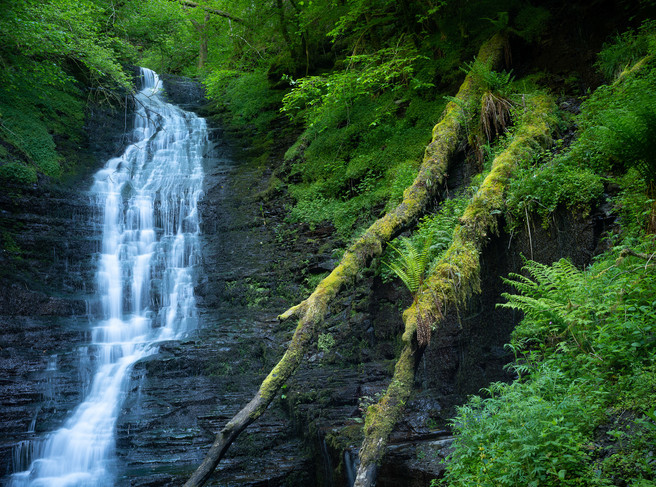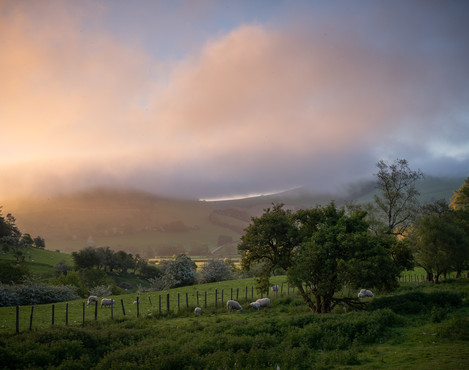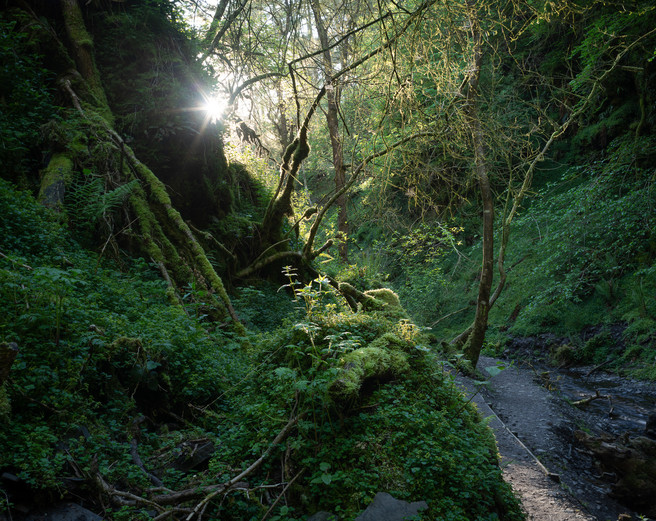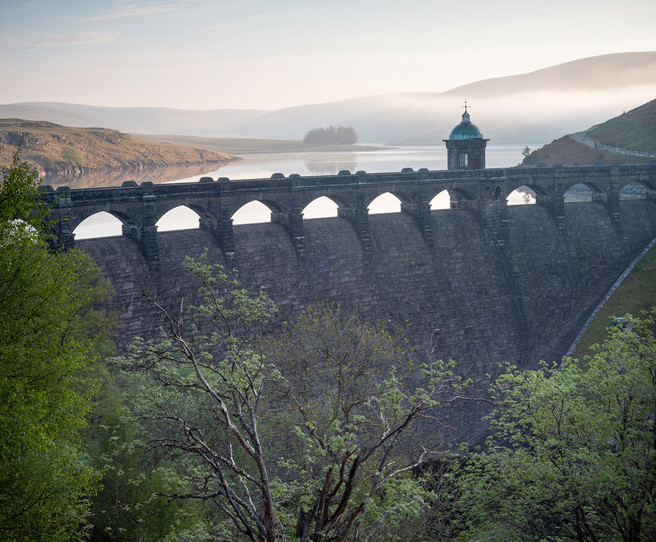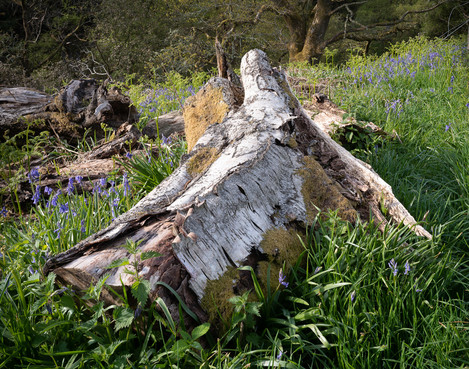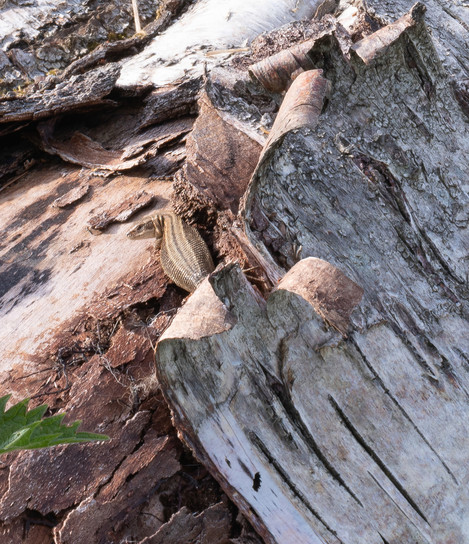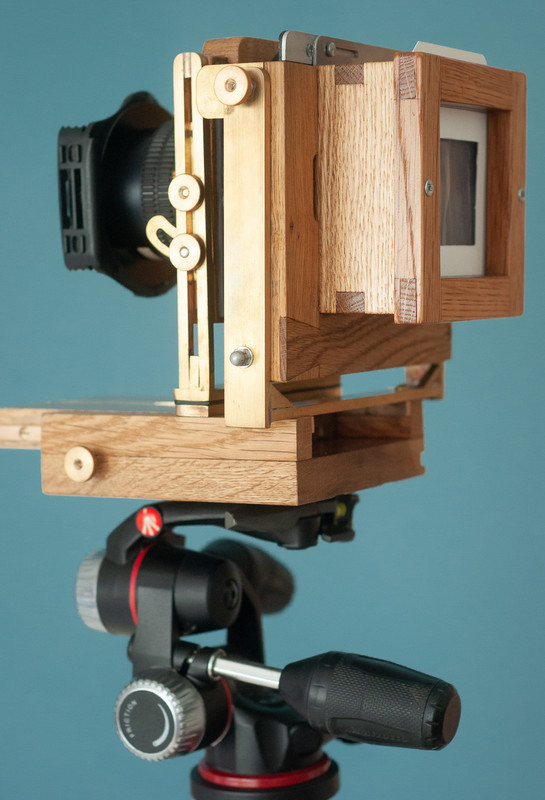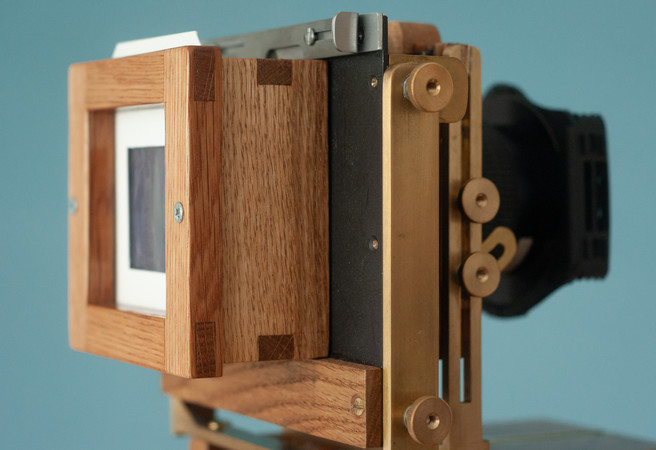Part II

Max Rush
Max A Rush is a professional landscape photographer specialising in London’s parks and gardens. With a background in art, music and natural history, he first became interested in photography while working as a naturalist for the national parks service in Quebec. He continued his studies in the UK with a series on the mid Wales landscape and then, on moving to London began photographing his local park.
In part one of this article, Max wrote about the idea and construction of his oak wood camera. In this second article, Max writes about the technical notes, field testing and further modifications.
Fame
The scent of blossom drifted through the iron gate. No one stirred in the twilight forest but between shadowed boughs shone the heady colours of the painted bushes. With miraculous luck, the snows of yester month had delayed the blossom more than ever before seen and at the beginning of May, many of the azaleas were still in bud.
With trepidation and internal bemusement, I set up the oaken camera amid the oaks and got to work. I spent a lot of time focusing and at times felt like nothing was really that close to being in focus. Keen to test every possible configuration I swapped medium and large format lenses frequently and applied camera movements galore. By around 7am the annual swarm of visitors began to pour in from every direction and the Mamiya lens mount was detaching itself from the lens board, adding droop to the residual tilt I couldn’t seem to rid myself of. Photographers began to gather, whispering, peering and speculating. I explained, demonstrated, justified and at times business carded to the crowds, using all the restraint I could manage not to mock the smart phoneys who follow the blossom-lined paths staring at nothing but the end of a selfie stick. I chatted with a busy dad enjoying an hour of freedom, a group of enthusiastic German tourists and had a lengthy discussion with one of the camera operators from 2001, A Space Odyssey. Solitary reflection ceded to lively socialising, of which like many of us I’ve been recently deprived.
I went home and took everything apart. I reattached the lens mount in a more favourable position, reset the rack and pinion mechanism, adjusted the shape of the front and rear standards in a vice and loaded the images, unsure whether I wanted to look at them or just get back out photographing.
Miniskirt
I found myself with little patience for looking through the images. The weather hadn’t been the best and I knew the poorly adjusted components had prevented me obtaining sharp focus in many of the images. I noticed that the skies were dustier than ever, making me wonder whether the exposed sensor was a serious problem in the design. I could redesign the back to incorporate a baffle protecting the sensor at one end of its travel, but also looked at the velvet bellows as a source of dust and contamination. Back to ransacking but this time in a charity shop, I finally found a black, fake leather miniskirt that was not only completely opaque (to the benefit of its intended user I’m sure) but fairly flexible. The inside was lined with thin matt fabric that didn’t look as much of a dust trap as the velvet, and the outside would look as good on a smart photographic tool as it would on a woman’s waist. As a proud Londoner who once entered a portrait of myself dressed as a woman in a grumpy old man camera club competition (“it’s something we’d never, ever do”) I bought the skirt with easy nonchalance.
The new bag bellows did look smarter but seemed a little stiff. With the medium format lenses, there was no problem but I wondered whether I’d be able to rack the front standard out far enough for the Schneider 90mm, or whether using rise would pull the bellows off the frame. I set my alarm for 4am again.
The Best camera
This time the overhauled camera met Isabella on one of her good air days, sunbeams pouring through the mist and every leaf and petal glistening with drops of overnight rain. Could I respond to this display of fleeting wonder with the heavy and as yet unproven camera? The desire to capture nature’s gift of light before forever lost can weigh heavily on the artist who unexpectedly gets what they want.
Awakened and focused thanks to my flask of espresso, I began to tackle my challenges with new confidence, knowing that if I could just master the idiosyncrasies of the controls, I would achieve results of unheard-of polish and refinement. I did have exactly the same back and the same lenses mounted on the same tripod as before, but now with the large influx of oak and brass between these elements, I had the true large format experience and the complete toolkit of controls I’d missed for so long. Scenes I would have struggled with using any other camera now became straightforward, more than anything because of the flexibility of having all the necessary movements (especially swing) available on a large mechanical scale and the means to study the entire field of view at once. Focusing and setting these movements on a small ground glass was easier than I’d imagined thanks to the large maximum apertures of the medium format lenses – all f/2.8 in fact, yielding very bright images with thin and precise focal planes, and being of modest angles of view, corner drop-off was minimal.
I’m currently reviewing the images from the first few trips – weeks later as the challenge of merging 8 or more 42MP frames is enough to break my computer. I still can’t quite believe what’s been born of a place so far removed from the pristine, high-tech factories of Japan, but now have the evidence that it seems to have worked – 150MP resolution, extensive movements, and as for the threat of flare, something yet more amazing – there is none to be seen at all, in any image. Scenes that would have lost contrast in my old Mirex adapter from unused parts of the image circle (despite careful shading with one hand) are now rendered in noticeably richer colours and tones, showing that my miraculously cheap and effective Mamiya lenses are even better than I thought. And finally, let it not be forgotten that as I, like you, aspire more to be an artist and naturalist than a camera enthusiast (or reviewer), the greatest reward is in the instrument responding to the performer in the most natural and unobtrusive way.
Technical Notes and Further Field Experience
For anyone still following this (and as you can’t buy this in a shop I do wonder whether anyone is) here are the basic specifications of the Rush Oak field camera:
Formats
Area covered by shifted sensor in two alternative patterns): 6x4.8cm=5x4, 80x36mm=6x12
Resolution
140MP for 5x4 ratio, 138MP for single row panoramic, potentially 150MP+ for double panoramic row, though not much used due to aspect ratio.
Back
Sony A7RII mounted on sliding plate assembly. The entire assembly, therefore, benefits from image stabilisation and live view focusing.
Lenses
Any medium format SLR lenses potentially compatible via commercially-made adaptors for Mamiya 645. Currently using Mamiya 55mm f/2.8N, Bronica 80mm f/2.8 PS, Mamiya 150mm f/2.8 A and on a separate lens board, Schneider 90mm f/5.6 Super Angulon. Large format lenses probably focusable to 180mm but current bag bellows considerably shorter to favour the medium format lenses’ close focus position.
In practice, I’ve found the medium format lenses to generally outperform the one large format lens I’ve been able to try, but I’m keen to carry on experimenting. The 90mm Schneider is designed to cover a large image circle, perhaps at the expense of the central region I’m using. Other LF lenses may present greater benefits if central sharpness matches that of medium format equivalents. All three medium format lenses were extensively used on a Mirex tilt/shift adapter, and now moved to the Rush camera they show the following improvements:
55mm N
Still capable of the largest shift before vignetting but now with improved colour and much lower incidence of veiling flare. Compact size and lightweight works very well on the camera and with a wide aperture is far easier to focus than an equivalent wide angle on 5x4. I only paid £60 for this lens and it’s a miracle.
80mm PS
Still the sharpest lens I regularly use but now covers a wider useable field (internal baffles caused vignetting on Mirex adapter with any vertical shift) and has improved colour rendition. Easier to mount and swap with other lenses in the field compared to the 90mm Schneider as no extension of the camera is required.
150mm f/2.8 A
Just about covers the 5x4 field without use of rise, whereas with the Mirex adapter was far more restricted. Extremely sharp and high contrast when wider apertures are possible, though for a lot of images they’re not. A bit on the heavy side so a challenge to keep the front standard tilt-free. Not as extensively tested in the field but awaiting its moment – perhaps for macro use as well as more conventional landscapes.
Wilderness test
Richmond Park is typical of the kind of environment I usually work in – a bit muddy but never too far from a path. At the end of May I took the camera to mid-Wales to visit some of the wilder spots I’ve photographed in recent years. These included the large, dramatic Elan Valley, and the beautiful hidden woodland waterfall known as Water-Break-Its-Neck at Coed Cwningar, Powys.
I also photographed distant border vistas from England’s highest golf course, Bradnor Hill. I didn’t have any concerns about how the camera would stand up to these environments, but it was useful to test it on some very different topography. It was also a welcome return to some old favourite locations, to be transformed I hoped not just by the new tool but by recent studies in atmospheric optics that have opened my eyes to new possibilities.
I’m still processing the images (bear in mind that I can’t see them until each one has been merged from its constituent frames in Lightroom) but everything seems to have worked well. In the field, the camera was as satisfying to use as it was in London, but it was nice to be able to try the “running up a rocky mountain” challenge with it on the tripod, which is a realistic test of vibration resistance. I aim to be in place calmly making my images as the sun rises, but in reality, sometimes sense an incredible wonder of nature unfolding somewhere quite different and have to resort to the laden sprint. In this case, the potential for some scintillating atmospheric optics led me to mount said mountain in record time, tearing through woodland, moorland and eventually some remote and probably private clear-felled upland plantation, to be greeted by the best fogbow I’ve yet seen.
I should also note that given a very limited window to make a photograph in short-lived conditions the camera can still function without ground glass viewing in the same way as the old tilt-shift adapter. As I still use the separate viewfinder in the field for rough composition (with new masks to account for the changes in format), I can quickly identify the centre point and position this in the Sony’s EVF with the backslider also centred. I try not to do this as it goes against the whole ethos of large format photography, but there have been occasions already where it was this or nothing at all. There have also been times when I’ve simply moved from 5x4 to panoramic format without reframing with the ground glass. Any need to add vertical shift to such a panorama in an already established setup can be achieved using the vertical movement on the back, which has the advantage of not affecting focus or moving tilt in any way.
At the canyon waterfall, I felt like a real nature photographer, boots in the river, icy water washing the mountain mud off battered tripod feet and above me a moss-festooned wonderland reminiscent of temperate rainforest.
In the Elan Valley, I watched fog rise and fall in the early summer dawn, alone on a craggy summit far from the land of Isabella. Maybe I needed a camera made from an old rowan tree? Then later in the day, I found a beautiful bluebell wood where I ended up on my knees, tilting to extremes to photograph a lustrous fallen birch trunk. Absorbed in my equally-prostrate focal plane I failed to notice a large lizard that had emerged from under the bark. The calm and quiet work of a large format photographer was no disturbance to wildlife and it remained for the whole experience.
“What didn’t work?” is what the camera reviewers always ask. What didn’t quite perform up to professional standards was my black t-shirt focusing cloth, which is infuriating. Dry and still it’s a simple and practical solution, but in a breeze it continually glues itself to my face or flips off the camera, or turns itself inside-out. Any recommendations for improved focusing t-shirts would be welcome. I did make a better one for my 5x4 camera but reluctant to admit that I don’t use it anymore (I’ve still got boxes of mouldy film and loaded dark slides) I don’t like to plunder that camera bag too much.
Late refinements
Finally, in summer 2021, I replaced the plastic chopping board back with a more polished oak one. It features a newly-ground glass and fresh Fresnel screen and has provision to adjust the precise distance from the rear standard. There are slot-in masks for 5x4 and panoramic fields of view, which unlike the old version won’t fall out when shaken violently.
The Orchard
I once built a telescope to do some astronomy, but feeling I could improve on the first one I built another one, and then another one, and then some years later again rekindling my former love of astronomy thought I could use another telescope or two, and I still had some spare lenses lying around. Likewise with the microscope, the electrostatic generator and now the view camera. At my family home near Wales (long out-of-bounds after the last two years) I revisited an old stock of hardwoods and thought about how much more I enjoyed working with some of them than I do with oak. The oak camera is far from perfect, with potential for improvements throughout its component parts. The sliding back could be more solidly built with an all-metal construction, allowing for a means to cover the sensor at one end of its travel, and with a minor adjustment of dimensions could also accommodate an even larger format.
The brass standards are just about aligned well enough to work, but with precision in mind, I’d like to redesign them in stainless steel and incorporate clearer stops at neutral positions of shift and swing.
The baseboard was designed to accommodate the draw of 180mm LF lenses and so had to extend far more than required by the MF ones I’ve mostly ended up using. If I decided to use these exclusively, I could design a much shorter, lighter and more compact baseboard, and with all the lenses sitting at the same distance there would be no need for a rack and pinion focusing mechanism – the lenses’ own screw would suffice, or I could incorporate a small amount of geared movement to allow for macro work. I could also dispense with the removable lens board and fit the Mamiya mount directly into a smaller front standard.
I found some good pieces of pear, a beautiful hard, fine-grained wood and also picked up some boxwood for smaller precise parts. Just in case I felt like adding black handles to the sliding back, I chose some pieces of ebony once plundered from a musical instrument supplier’s reject shed. I still like the idea of the camera being made of British trees though so will keep to these for the main body of the camera. I visited a beautiful private orchard during my stay and it occurred to me that this could be a theme for the new, refined camera – all the woods would be from fruit trees. I have some pieces of apple for additional reddish colour inlay, and even the ebony, while not exactly a British wood, is I understand from a tree in the Persimmon family.
I’m sure this will all take some time to materialise, but I feel it’s become a certainty rather than a dream. No inventor would be satisfied at leaving a concept half-explored and when the invention is also a tool of your trade, the incentive is even higher. Will anyone read the review though?

